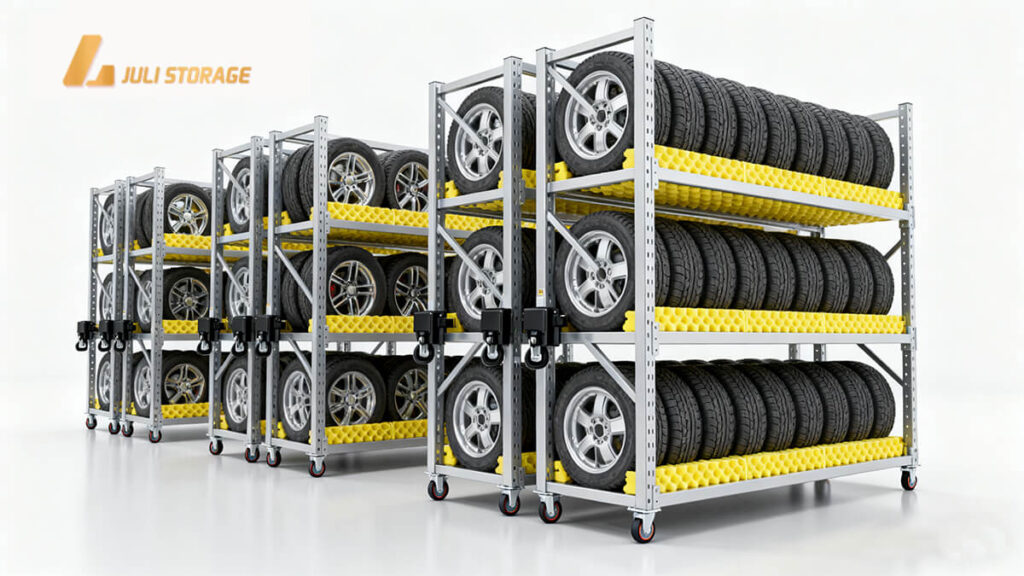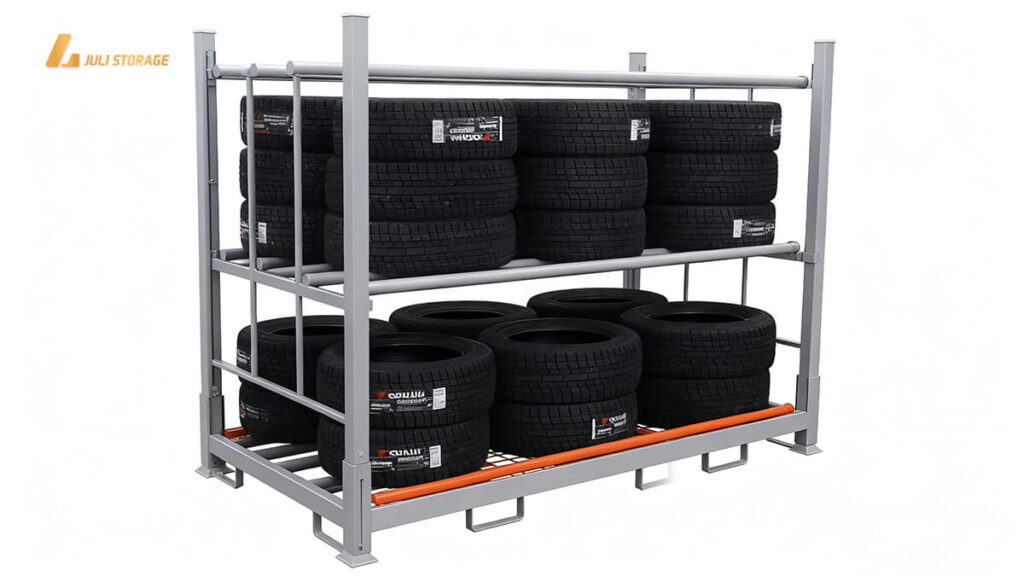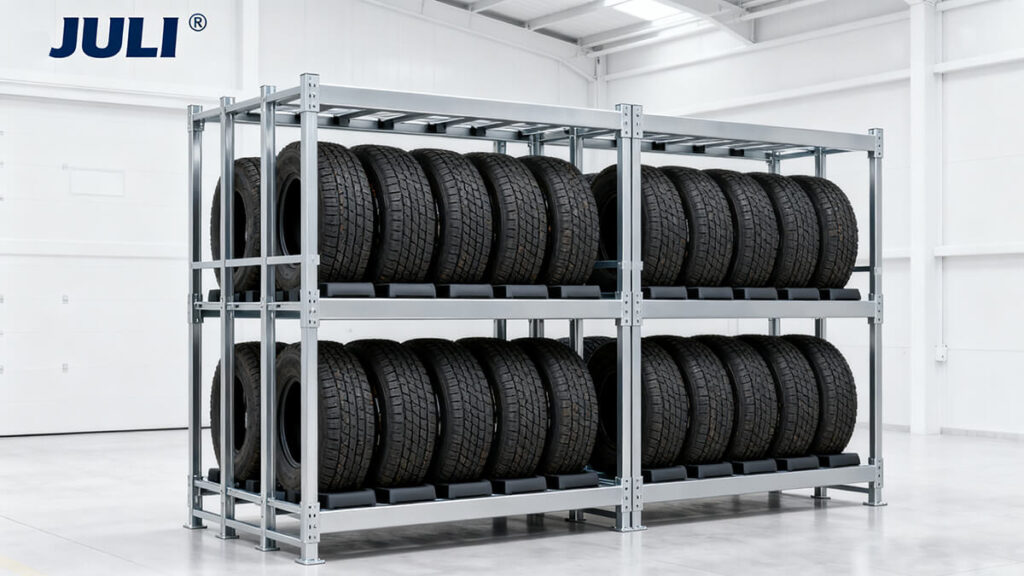How Do I Store Tires Safely and Efficiently?
- Company News
- September 26, 2025
- 8:32 pm
Tire storage is a critical—yet often overlooked—part of the tire lifecycle. Improper practices can shorten tire life, cause deformation, and create safety risks. As a global tire rack manufacturer, JULI® has supplied advanced tire storage systems to dealerships, warehouses, and automotive service centers worldwide. This guide shares proven guidelines and real-world insights to help protect your investment and maximize warehouse efficiency.

Table of Contents
- 1. Why Proper Tire Storage Matters
- 2. Key Storage Conditions: Environment Requirements
- 3. Storage Methods: Mounted vs. Unmounted Tires
- 4. Tire Rack & Storage System Design Considerations
- 5. Rack Layout, Stacking & Safety Guidelines
- 6. Maintenance & Periodic Inspection
- 7. Common Mistakes & How to Avoid Them
- 8. Case Studies
- 9. Conclusion & Call to Action
- 10. FAQs
1. Why Proper Tire Storage Matters
-
Protect Rubber Integrity: UV light and ozone accelerate rubber aging.
-
Prevent Deformation: Poor stacking or long-term pressure causes flat spots.
-
Extend Service Life: Proper storage preserves near-factory performance and reduces scrap rates.
- Increase Operational Efficiency: Professional JULI® rack designs can recoup investment within months through space savings and faster picking.

2. Key Storage Conditions: Environment Requirements
| Factor | Recommended Range | Notes |
|---|---|---|
| Temperature | 10–25 °C | High heat accelerates aging; low temp causes brittleness. |
| Humidity | 40–60% RH | Excess humidity leads to mold; low humidity hardens rubber. |
| Light | No direct sunlight | UV damages molecular chains. |
| Ventilation | Mild air flow | Maintains stable temperature; avoid strong drafts. |
| Chemicals | Keep away from oils/ozone | Prevents chemical corrosion. |
3. Storage Methods: Mounted vs. Unmounted Tires
-
Unmounted Tires: Store upright and rotate slightly every few weeks.
-
Mounted Tires: Hang or stack horizontally with protective padding and spacing.
- Long-term Vehicle Parking: Lift the vehicle or move it periodically to avoid flat spots.
4. Tire Rack & Storage System Design Considerations
JULI® global project experience highlights key principles:
-
Modular & Scalable to accommodate future expansion.
-
High Load Safety Factor: ≥1.5× rated capacity.
-
Rounded/Padded Contact Surfaces to avoid sharp pressure points.
-
Optimized Aisles & Picking Paths for forklifts and manual handling.
-
Anti-dust & Anti-corrosion Finish for low-maintenance operation.
-
RFID/IoT Ready to enable smart warehouse upgrades.
5. Rack Layout, Stacking & Safety Guidelines
-
Workflow Priority: Minimize cross-traffic.
-
Stacking Rules: Heavy tires on bottom; limit stacking height.
-
Operational Protocols: Use dedicated tire handling equipment.
-
Label Management: Integrate WMS with barcode or RFID for quick inventory checks.
6. Maintenance & Periodic Inspection
Quarterly Tire Check: Inspect for cracks, bulges, and surface damage.
Rack Inspection: Tighten bolts and check anti-rust coatings.
Environment Monitoring: Ensure ventilation and dehumidifiers operate correctly.
- Staff Training: Conduct safety drills and emergency preparedness sessions.

7. Common Mistakes & How to Avoid Them
| Mistake | Risk | Solution |
|---|---|---|
| Direct floor stacking | Moisture and aging | Elevate with JULI® professional racks |
| Over-stacking | Deformation | Control stack height; use separators |
| Storing near heat source | Accelerated aging | Keep away from heaters and machinery |
| Skipping inspections | Hidden structural issues | Implement a strict inspection schedule |
8. Case Studies
Project Example: European Dealership HQ Warehouse
Challenge: 8 m ceiling height, diverse tire sizes, limited forklift access.
Solution: JULI® three-tier modular racks with sliding rails and IoT monitoring.
Result: 45% increase in storage density and 30% faster picking, with seamless future expansion.
9. Conclusion & Call to Action
10. FAQs
A: Short term is acceptable, but use JULI® racks for long-term moisture protection.
A: Yes, but remove excess air and keep them dry to prevent trapped moisture.
A: Without racks, no more than 3–4 tires; with JULI® racks, follow the design load rating.
A: Store with whitewalls inward and black rubber outward.
A: Light inflation helps maintain shape; unmounted tires do not need inflation.
Popular Recommendations
- Most popular products
What to Expect When You Reach Out
- Friendly and timely response within 6 hours
- Solutions tailored to your specific needs
- Comprehensive support in products, technology, and market trends

